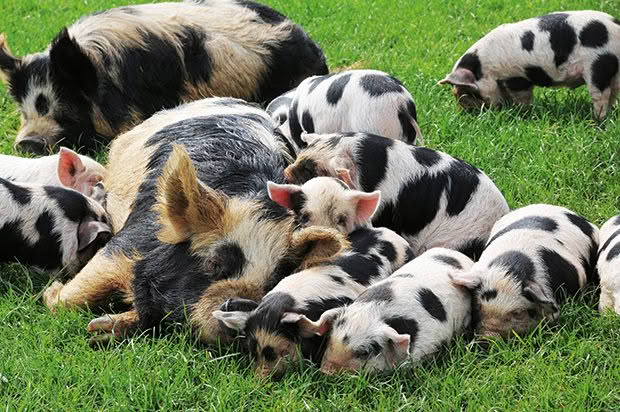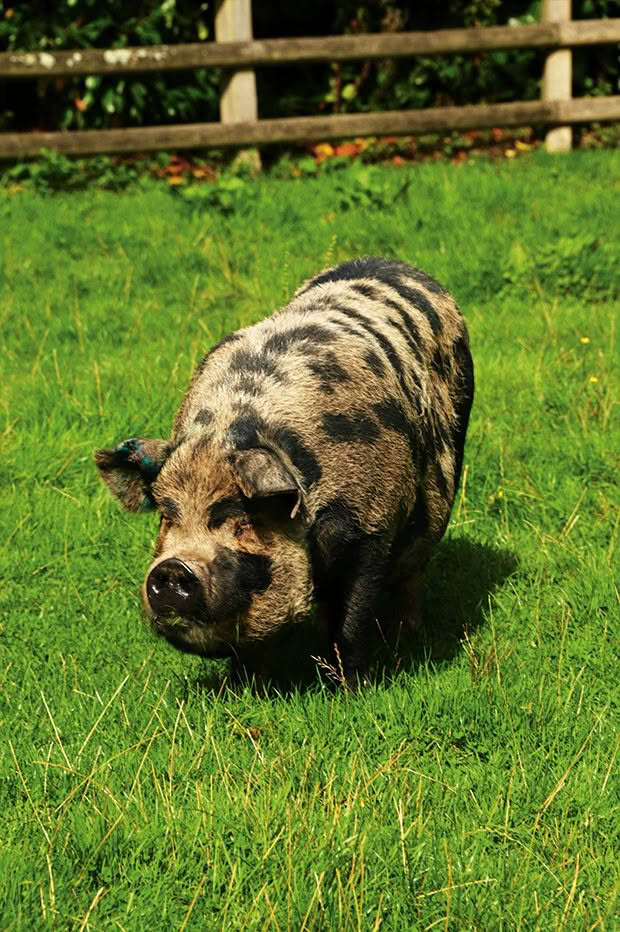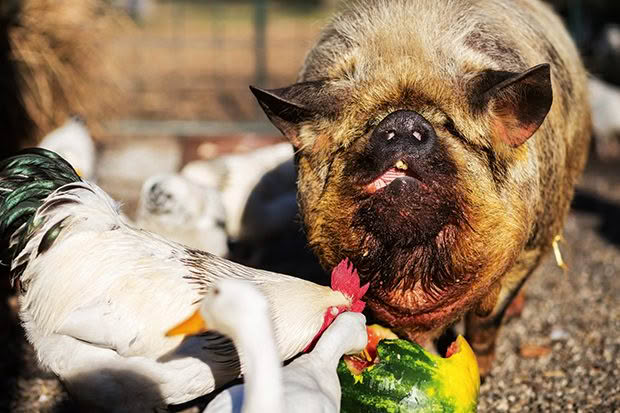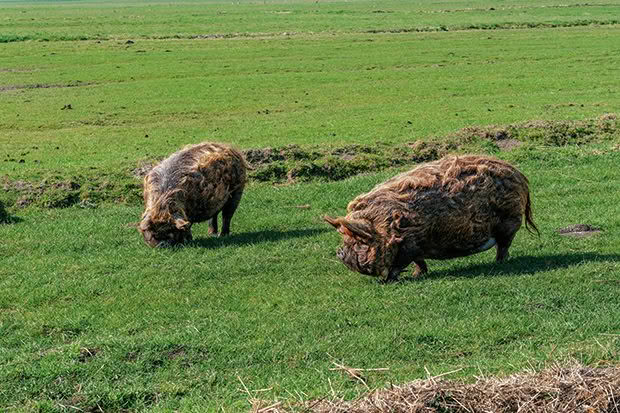The rise of the kunekune

Aotearoa’s beloved roly-poly piggies are making a big noise overseas – with good reason.
Words: Michael Andrew
Out of all of New Zealand’s typical farm animals, kunekune are arguably the most quintessentially Kiwi. These pigs have become a mainstay of New Zealand farms and rural properties, charming everyone they meet with their portly frames, distinct chin tassels (piripiri) and lovely, docile temperaments.
But such awesome animals can’t be kept secret for long, and it was only a matter of time before the rest of the world caught on. In recent years, a wave of overseas farmers and homesteaders – particularly in the
US – have been discovering the marvel that is the kunekune and adding them to their properties.
A quick google search will reveal dozens, if not hundreds, of US farms and enthusiasts praising the novel merits of the swine, which is widely viewed as a rare and one-of-a-kind collectors breed and the “ideal” pig for the smaller farm or homestead.
While some pigs are kept simply for their conveniently small size, low feed needs and friendly companionship, many pigs are kept for their meat. Kunekune meat is not often on the menu in New Zealand, but in the US it is regarded by breeders as a succulent pork with “rich marbling, beautiful lard and strong heritage pork taste,” and is reportedly being introduced to chefs around the country.
But it’s kunekune’s ability to graze that is its most valued trait. Unlike other swine that forage for their food, much of the kunekune’s diet consists of grazed grass, supplemented with feed, hay and fresh produce.

Their short, upturned noses mean they can graze without rooting up pasture and clear paddocks with ease, getting most of their food needs at the same time.
An article published on the US website Modern Farmer reported that 25 kunekune were being used to help restore the soil of a 47-acre former tobacco farm in North Carolina. The farmer, Rachel Herrick of Slow Farm, had initially used goats to clear the weed overgrowth, but because they only eat weeds at ground level, she turned to kunekunes instead. The pigs are now an integral part of her farm system, happily clearing the weeds that other livestock won’t touch while leaving behind a nourishing manure to replenish the soil.
“They munch broadleaf weeds and leave behind this beautiful, pretty pH-neutral poo that the dung beetles go crazy [for],” she said. “If you can get your dung beetles excited about the project, they’ll do so much of the work for you. They make all the [pig] poop into tiny little balls and then tuck it like an inch below the soil for you. That’s exactly what you want if you’re trying to build topsoil.
“They [kunekunes] keep pasture systems balanced so that unpopular plants can’t just take over,” she said.
Because the pigs can easily fatten through a diet of mostly grazed grass and weeds, they require far less commercial pig feed than other breeds, making them a very cost-effective option for a small farm or homestead. Another perk cited by US farmers was that kunekunes don’t challenge or damage fences, saving a lot of repair and maintenance time. They emit a mild odour, are good around children and tend to get along with most other farm animals.
TOP TIPS FOR KUNEKUNE CARE

FOOD
While kunekune require approximately 75% less grain than commercial pigs, they still need some grain to supplement their grazing and complete their diet, especially when pasture quality and quantity diminishes.
The New Zealand Kunekune Association (NZKA) recommends the below feed rate of commercial pellets made with 12 to 16.5% protein, when there is some pasture available.
– adult boar or sow – 1 to 1.5kg per day
– lactating sow – 1 to 1.5kg + 0.2kg/piglet/day
– piglets 2-4 months – 0.5kg per day
– pigs 4-9 months – 0.75kg per day
Pigs should be fed twice a day when grass is poor, and have ready access to clean water. Adult sows can drink up to five litres of water a day during lactation, particularly during hot weather.
SPACE, SHELTER AND FENCING
To satisfy their urge to graze, kunekunes should be given a 10th of a hectare (quarter acre) of pasture per pig.
While settled pigs are not known to challenge fencing, it’s wise to install good netting fences, electric fences, or a single hot wire to prevent any escapes.
Pigs are not heat tolerant and so need an area of shade or a well-ventilated shelter in summer. Given the chance, they will make a mud wallow to keep themselves cool and keep the flies off.
The ideal pig shelter is one that is big enough to hold all the pigs with some room to spare, is well ventilated but not draughty, and will keep out the rain. A solid floor is best, and bedding such as shavings or sawdust can be added for warmth.
SOCIAL LIVES
A study by the University of Veterinary Medicine in Vienna found that kunekunes develop complex social families, teaching, collaborating and learning from each other. Kunekunes are herd animals – they are far happier and healthier when kept in pairs or groups. Many breeders run the boar and sows together for long periods of time and only separate them at farrowing time.
While they will usually graze quite happily with other stock in a paddock, they are known to eat afterbirths from other animals and may sometimes take baby lambs and goats. For this reason, don’t run kunekunes in with other stock at birthing time.

BUYING A KUNEKUNE
Where possible, buy registered stock from a respected breeder. Kunekunes vary in size, shape and colouring, so there is always a matter of personal preference as to what looks like a desirable pig. The main things to look for are a short snout, tassels present, healthy legs and feet, and good temperament.
Where possible, buy two together so that they are company for each other. When taking a new pig or piglet home, put them in a secure pen or small paddock for the first few days until they recognise you as the food source. Once they have settled down and are not under stress, it is ok to let them out but be aware that they will explore opportunities for escape.
HEALTH
Kunekunes, like other grazing animals, can be prone to internal parasites that sap their nutrients and generally erode their condition, making them more susceptible to illness. According to Slow Farm, the best ways to treat or prevent parasites in kunekunes are:
• chemical dewormers such as Ivermectin
• rotational grazing. This is when the pigs are moved to new pastures regularly before the parasite eggs hatch. Without a host, the worms die off and eventually your farm’s parasite population can be greatly reduced. The downside to rotational grazing is it requires a lot more work.
Sources: New Zealand Kunekune Association and Slow Farm
Love this story? Subscribe now!
 This article first appeared in NZ Lifestyle Block Magazine.
This article first appeared in NZ Lifestyle Block Magazine.
